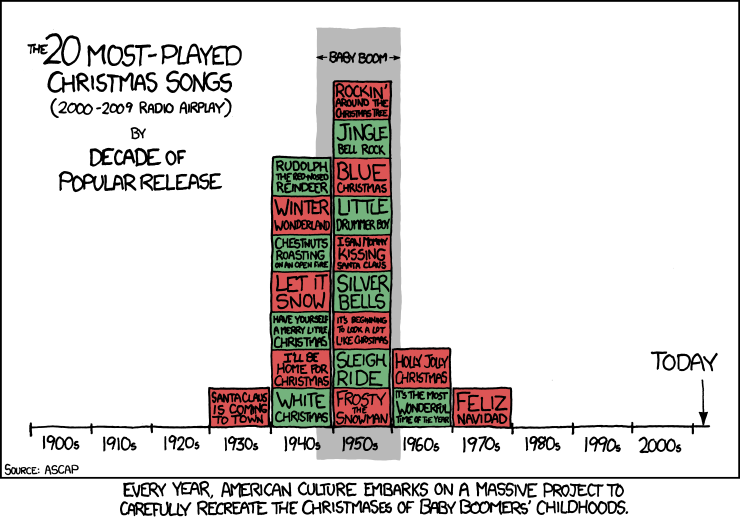December 9, 2011
#988: Tradition explain

The 20 most-played Christmas songs (2000-2009 radio airplay) by decade of popular release
[A bar chart labeled on the X-axis with the decades “1900s” through “2000s” labeled. Each bar has, as one unit, a labeled song. A section of the graph between 1947 and 1962 has a dark-gray extension column, containing the label “Baby Boom” between a pair of arrows pointing at the edges .
“1900s”, “1910s”, “1920s”, “1980s”, “1990s”, and “2000s” are empty.
“1930s” has “Santa Claus is Coming to Town”.
“1940s” has “Rudolph the Red-Nosed Reindeer”, “Winter Wonderland”, “Chestnuts Roasting on an Open Fire”, “Let it Snow”, “Have Yourself a Merry Little Christmas”, “I’ll be Home for Christmas”, and “White Christmas”.
“1950s” has “Rockin’ Around the Christmas Tree”, “Jingle Bell Rock”, “Blue Christmas”, “Little Drummer Boy”, “I Saw Mommy Kissing Santa Claus”, “Silver Bells”, “It’s Beginning to Look a Lot Like Christmas”, “Sleigh Ride”, and “Frosty the Snowman”
“1960s” has “Holly Jolly Christmas” and “It’s the Most Wonderful Time of the Year”
“1970s” has “Feliz Navidad”
The songs are coloured red and green, alternating between squares horizontally and vertically so that all tiles contrast against any direct neighbours in a check-pattern.
Rockin’ Around the Christmas Tree, Blue Christmas, Winter Wonderland, I Saw Mommy Kissing Santa Claus, Let It Snow, It’s Beginning to Look a Lot Like Christmas, I’ll be Home for Christmas, Holly Jolly Christmas, Santa Claus is Coming to Town, Frosty the Snowman, and Feliz Navidad are red.
Jingle Bell Rock, Rudolph the Red-Nosed Reindeer, Little Drummer Boy, Chestnuts Roasting on an Open Fire, Silver Bells, Have Yourself a Merry Little Christmas, Sleigh Ride, White Christmas, and It’s The Most Wonderful Time of the Year are all green.]
Every year, American culture embarks on a massive project to carefully recreate the Christmases of Baby Boomers’ childhoods.